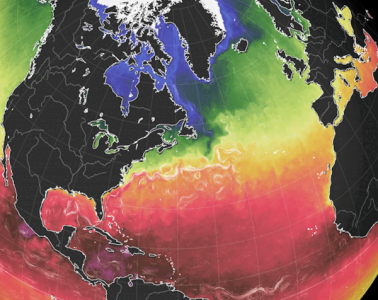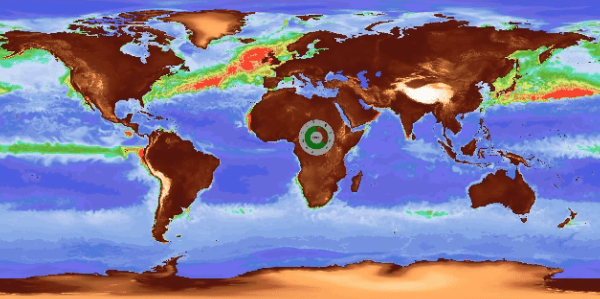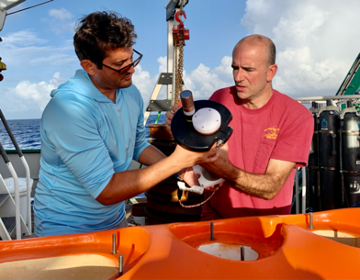Knowledge gap and key role of the circulation
The Gulf Stream transports old waters, high in nutrients and biological carbon but depleted in anthropogenic carbon, into the North Atlantic at around 26°N through Florida Straits. As it flows further northwards, the current grows in strength, and these waters are mixed into the winter mixed layer where they can sustain biological activity and carbon uptake.

Sea surface temperature and surface currents from https://earth.nullschool.net

Primary Production Output from NEMO-MEDUSA ocean-BGC model, courtesy Andrew Yool, NOC.
However, our prior work has shown that the volume transport grows proportionately more than the nutrient transport, consistent with dilution by lower-nutrient waters or nutrient consumption. Such dilution processes may involve isopycnal stirring or diapycnal mixing, or indeed biological processes. With projections of changes in the overturning circulation strength, stratification / ocean warming and associated deoxygenation, there is significant uncertainty as to how these dilution processes will respond, and the potential impact on biological production and carbon fluxes downstream.
Our new observations through three directed fieldwork campaigns hope to answer such knowledge gaps, making a comprehensive assessment of these processes along the Gulf Stream to ascertain their relative importance in contributing to the nutrient and carbon stream.

Preparation of the Stablemoor float, with integrated sensors (left) and deployment of the McLane RAS autonomous water sampler (right) Photos: Pete Brown, NOC
Moorings:
Firstly, we are deploying an array of three deep moorings in Florida Straits carrying 15+ multi-disciplinary instruments (temperature, salinity, pressure, oxygen, pH, pCO2, nitrate, ADCP). Designed to capture the core of the high nutrient / low-carbon streams, as well as the property gradients across the interface between the horizontal and overturning components of the flow, the moorings will be in the water between 2023 and 2025. The 24-month timeseries generated will enable us to determine the strength, variability and controls of the transport of nutrients and carbon at the start of the Gulf Stream, as the current exits the Florida Straits.


Preparation of the Stablemoor float, with integrated sensors (left) and deployment of the McLane RAS autonomous water sampler (right) Photos: Pete Brown, NOC




Pictures left to right, 1.Installation of a pCO2 senor into the top of the mooring, 2.the mooring wire with hairy fairing. 3.Fixing of biogeochemical sensors into their mooring frame. 4.The RAs water sampler ready for deployment at the bottom of Florida Straits. Photo credits: Lisa Beal (U.Miami)
Gliders
To assess the physical context of Gulf Stream mixing, a number of gliders are to be deployed from the Florida Straits, measuring ocean turbulence in addition to the standard suite of sensors (CTD, oxygen and bio-optics). Progressing northwards, they will be piloted to undertake periodic westward transects into the core of the Gulf Stream over a period of 3-4 months, moving through the core of high-nutrient/low anthropogenic carbon waters. These new targeted physical observations will allow us to assess the physical contributions from diapycnal mixing and advection (directed across a density surface) and isopycnal stirring and advection (directed along a density surface), and their relation to the waters of the subtropical gyre.

Photos: Louis Clement, NOC & Pete Brown, NOC

Two gliders with microturbulence sensors integrated (left). One of the gliders being deeployed in August 2023 (right) Photos: Louis Clement, NOC & Pete Brown, NOC
MARS Glider fleet finder LINK
Floats
To document in detail the downstream evolution of the Gulf Stream’s physical and biogeochemical properties as far as the subpolar North Atlantic, a number of biogeochemical Argo floats have been deployed in Florida Straits in summer 2023. Measuring oxygen, nitrate, pH, chlorophyll-a, suspended particles and irradiance, and profiling more frequently than standard (every 2-3 days compared to every 10 days) the floats will enable us to document the evolving biogeochemical properties of the nutrient and carbon streams. ‘Parking' the floats within the core of the high nutrient/low anthropogenic carbon waters at approximately 600-1000m, between profiles. Will also allow them to best track the movement of these waters northwards.

BGC-Argo floats ready for deployment Photos: Pete Brown, NOC

The pathways of the floats in August-September 2023 :

Historical distributions of nitrate

Anthropogenic carbon along the path of the Gulf Stream, showing the anomalous subsurface concentrations emanating from Florida Straits. Photo: Pete Brown
Track the progress of the C-Streams BGC Argo floats:
And also the core Argo floats that were deployed in late 2022 to assist in piloting strategy: